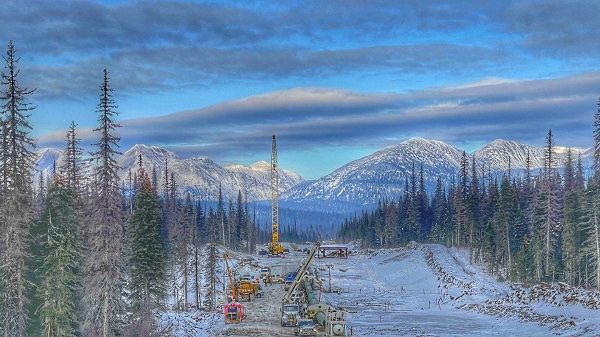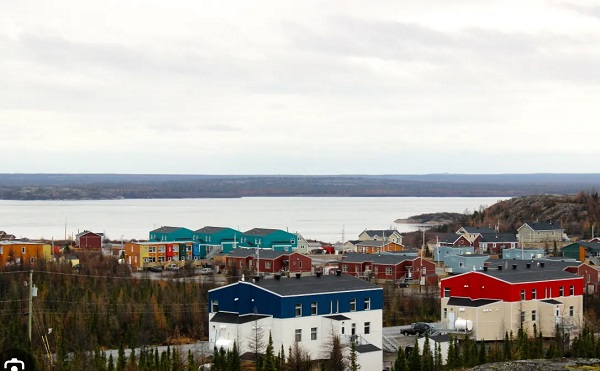Alberta
U.S. tariffs or not, Canada needs to build new oil and gas pipeline space fast

From the Canadian Energy Centre
Expansion work underway takes on greater importance amid trade dispute
Last April, as the frozen landscape began its spring thaw, a 23-kilometre stretch of newly built pipeline started moving natural gas across northwest Alberta.
There was no fanfare when this small extension of TC Energy’s Nova Gas Transmission Limited (NGTL) system went online – adding room for more gas than all the homes in Calgary use every day.
It’s part of the ongoing expansion of the NGTL system, which connects natural gas from British Columbia and Alberta to the vast TC Energy network. In fact, one in every 10 molecules of natural gas moved across North America touches NGTL.
With new uncertainty emerging from Canada’s biggest oil and gas customer – the United States – there is a rallying cry to get new major pipelines built to reach across Canada and to wider markets.
Canada’s Natural Resources Minister Jonathan Wilkinson recently said the country should consider building a new west-east oil pipeline following U.S. President Donald Trump’s threat of tariffs, calling the current lack of cross-country pipelines a “vulnerability,” CBC reported.
“I think we need to reflect on that,” Wilkinson said. “That creates some degree of uncertainty. I think, in that context, we will as a country want to have some conversations about infrastructure that provides greater security for us.”
Many industry experts see the threat to Canada’s economy as a wake-up call for national competitiveness, arguing to keep up the momentum following the long-awaited completion of two massive pipelines across British Columbia over the last 18 months. Both of which took more than a decade to build amidst political turmoil, regulatory hurdles, activist opposition and huge cost overruns.
On May 1, 2024, the Trans Mountain pipeline expansion (TMX) started delivering crude oil to the West Coast, providing a much-needed outlet for Alberta’s growing oil production.
Several months before that, TC Energy finished work on the 670-kilometre Coastal Gaslink pipeline, which provides the first direct path for Canadian natural gas to reach international markets when the LNG Canada export terminal in Kitimat begins operating later this year.
TMX and Coastal GasLink provide enormous benefits for the Canadian economy, but neither are sufficient to meet the long-term growth of oil and gas production in Western Canada.
More oil pipeline capacity needed soon
TMX added 590,000 barrels per day of pipeline capacity, nearly tripling the volume of crude reaching the West Coast where it can be shipped to international markets.
In less than a year, the extra capacity has enabled Canadian oil production to reach all-time highs of more than five million barrels per day.
More oil reaching tidewater has also shrunk the traditional discount on Alberta’s heavy oil, generating an extra $10 billion in revenues, while crude oil exports to Asia have surged from $49 million in 2023 to $3.6 billion in 2024, according to ATB analyst Mark Parsons.
 With oil production continuing to grow, the need for more pipeline space could return as soon as next year, according to analysts and major pipeline operators.
With oil production continuing to grow, the need for more pipeline space could return as soon as next year, according to analysts and major pipeline operators.
Even shortly after TMX began operation, S&P Global analysts Celina Hwang and Kevin Birn warned that “by early 2026, we forecast the need for further export capacity to ensure that the system remains balanced on pipeline economics.”
Pipeline owners are hoping to get ahead of another oil glut, with plans to expand existing systems already underway.
Trans Mountain vice-president Jason Balasch told Reuters the company is looking at projects that could add up to 300,000 barrels per day (bpd) of capacity within the next five years.
Meanwhile, Canada’s biggest oil pipeline company is working with Alberta’s government and other customers to expand its major export pipelines as part of the province’s plan to double crude production in the coming years.
Enbridge expects it can add as much as 300,000 bpd of capacity out of Western Canada by 2028 through optimization of its Mainline system and U.S. market access pipelines.
Enbridge spokesperson Gina Sutherland said the company can add capacity in a number of ways including system optimizations and the use of so-called drag reducing agents, which allow more fluid to flow by reducing turbulence.
LNG and electricity drive strong demand for natural gas
Growing global demand for energy also presents enormous opportunities for Canada’s natural gas industry, which also requires new transportation infrastructure to keep pace with demand at home and abroad.
The first phase of the LNG Canada export terminal is expected to begin shipping 1.8 billion cubic feet of gas per day (Bcf/d) later this year, spurring the first big step in an expected 30 per cent increase in gas production in Western Canada over the next decade.
With additional LNG projects in development and demand increasing, the spiderweb of pipes that gathers Alberta and B.C.’s abundant gas supplies need to continue to grow.
TC Energy CEO Francois Poirier is “very bullish” about the prosect of building a second phase of the recently completed Coastal GasLink pipeline connecting natural gas in northeast B.C. to LNG terminals on the coast at Kitimat.
The company is also continuously expanding NGTL, which transports about 80 per cent of Western Canada’s production, with more than $3 billion in growth projects planned by 2030 to add another 1 Bcf/d of capacity.
Meanwhile Enbridge sees about $7 billion in future growth opportunities on its natural gas system in British Columbia.
In addition to burgeoning LNG exports from Canada, the U.S. and Mexico, TC Energy sees huge potential for gas to continue replacing coal-fired electricity generation, especially as a boom in power-hunger data centres unfolds.
With such strong prospects for North America’s highly integrated energy system, Poirier recently argued in the Wall Street Journal that leaders should be focused on finding common ground for energy in the current trade dispute.
“Our collective strength on energy provides a chance to expand our economies, advance national security and reduce global emissions,“ he wrote in a Feb. 3 OpEd.
“By working together across North America and supporting the free flow of energy throughout the continent, we can achieve energy security, affordability and reliability more effectively than any country could achieve on its own.”
Alberta
Made in Alberta! Province makes it easier to support local products with Buy Local program

Show your Alberta side. Buy Local. |
When the going gets tough, Albertans stick together. That’s why Alberta’s government is launching a new campaign to benefit hard-working Albertans.
Global uncertainty is threatening the livelihoods of hard-working Alberta farmers, ranchers, processors and their families. The ‘Buy Local’ campaign, recently launched by Alberta’s government, encourages consumers to eat, drink and buy local to show our unified support for the province’s agriculture and food industry.
The government’s ‘Buy Local’ campaign encourages consumers to buy products from Alberta’s hard-working farmers, ranchers and food processors that produce safe, nutritious food for Albertans, Canadians and the world.
“It’s time to let these hard-working Albertans know we have their back. Now, more than ever, we need to shop local and buy made-in-Alberta products. The next time you are grocery shopping or go out for dinner or a drink with your friends or family, support local to demonstrate your Alberta pride. We are pleased tariffs don’t impact the ag industry right now and will keep advocating for our ag industry.”
Alberta’s government supports consumer choice. We are providing tools to help folks easily identify Alberta- and Canadian-made foods and products. Choosing local products keeps Albertans’ hard-earned dollars in our province. Whether it is farm-fresh vegetables, potatoes, honey, craft beer, frozen food or our world-renowned beef, Alberta has an abundance of fresh foods produced right on our doorstep.
Quick facts
- This summer, Albertans can support local at more than 150 farmers’ markets across the province and meet the folks who make, bake and grow our food.
- In March 2023, the Alberta government launched the ‘Made in Alberta’ voluntary food and beverage labelling program to support local agriculture and food sectors.
- Through direct connections with processors, the program has created the momentum to continue expanding consumer awareness about the ‘Made in Alberta’ label to help shoppers quickly identify foods and beverages produced in our province.
- Made in Alberta product catalogue website
Related information
Alberta
Province to expand services provided by Alberta Sheriffs: New policing option for municipalities

Expanding municipal police service options |
Proposed amendments would help ensure Alberta’s evolving public safety needs are met while also giving municipalities more options for local policing.
As first announced with the introduction of the Public Safety Statutes Amendment Act, 2024, Alberta’s government is considering creating a new independent agency police service to assume the police-like duties currently performed by Alberta Sheriffs. If passed, Bill 49 would lay additional groundwork for the new police service.
Proposed amendments to the Police Act recognize the unique challenges faced by different communities and seek to empower local governments to adopt strategies that effectively respond to their specific safety concerns, enhancing overall public safety across the province.
If passed, Bill 49 would specify that the new agency would be a Crown corporation with an independent board of directors to oversee its day-to-day operations. The new agency would be operationally independent from the government, consistent with all police services in Alberta. Unlike the Alberta Sheriffs, officers in the new police service would be directly employed by the police service rather than by the government.
“With this bill, we are taking the necessary steps to address the unique public safety concerns in communities across Alberta. As we work towards creating an independent agency police service, we are providing an essential component of Alberta’s police framework for years to come. Our aim is for the new agency is to ensure that Albertans are safe in their communities and receive the best possible service when they need it most.”
Additional amendments would allow municipalities to select the new agency as their local police service once it becomes fully operational and the necessary standards, capacity and frameworks are in place. Alberta’s government is committed to ensuring the new agency works collaboratively with all police services to meet the province’s evolving public safety needs and improve law enforcement response times, particularly in rural communities. While the RCMP would remain the official provincial police service, municipalities would have a new option for their local policing needs.
Once established, the agency would strengthen Alberta’s existing policing model and complement the province’s current police services, which include the RCMP, Indigenous police services and municipal police. It would help fill gaps and ensure law enforcement resources are deployed efficiently across the province.
Related information
-

 Business1 day ago
Business1 day agoChina, Mexico, Canada Flagged in $1.4 Billion Fentanyl Trade by U.S. Financial Watchdog
-

 2025 Federal Election2 days ago
2025 Federal Election2 days agoTucker Carlson Interviews Maxime Bernier: Trump’s Tariffs, Mass Immigration, and the Oncoming Canadian Revolution
-

 espionage1 day ago
espionage1 day agoEx-NYPD Cop Jailed in Beijing’s Transnational Repatriation Plot, Canada Remains Soft Target
-

 Business2 days ago
Business2 days agoDOGE Is Ending The ‘Eternal Life’ Of Government
-

 2025 Federal Election1 day ago
2025 Federal Election1 day agoBREAKING from THE BUREAU: Pro-Beijing Group That Pushed Erin O’Toole’s Exit Warns Chinese Canadians to “Vote Carefully”
-

 2025 Federal Election2 days ago
2025 Federal Election2 days agoCanada drops retaliatory tariffs on automakers, pauses other tariffs
-

 Daily Caller1 day ago
Daily Caller1 day agoTrump Executive Orders ensure ‘Beautiful Clean’ Affordable Coal will continue to bolster US energy grid
-

 Daily Caller1 day ago
Daily Caller1 day agoDOJ Releases Dossier Of Deported Maryland Man’s Alleged MS-13 Gang Ties






